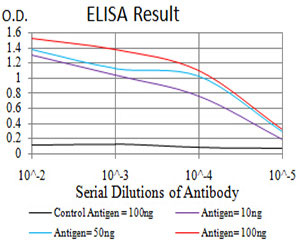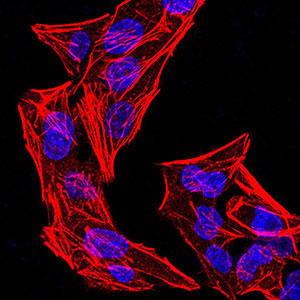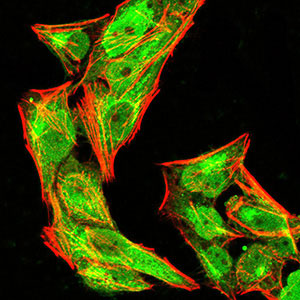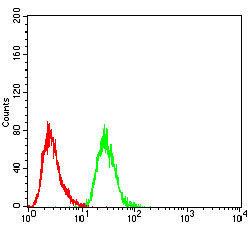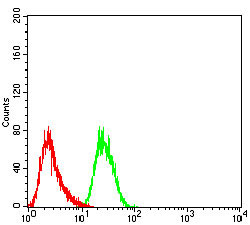phospho-NLRC4(Ser-533) Antibody
Purified Rat Monoclonal Antibody
- 产品详情
- 实验流程
Application
| FC, ICC, E |
|---|---|
| Primary Accession | Q3UP24 |
| Reactivity | Human |
| Host | Mouse |
| Clonality | Monoclonal |
| Clone Names | 9A6A1 |
| Isotype | IgG1 |
| Calculated MW | 116749 Da |
| Description | NLRC4 is a cytosolic NOD (nucleotide binding and oligomerization domain)-like receptor (NLR) that can trigger inflammasome formation in response to bacterial flagellin, an immunodominant antigen in the intestine. |
| Immunogen | Synthesized peptide of mouse phospho-NLRC4(Ser-533) (AA: 525-538) expressed in E. Coli. |
| Formulation | Purified antibody in PBS with 0.05% sodium azide |
| Gene ID | 268973 |
|---|---|
| Other Names | NLR family CARD domain-containing protein 4, Caspase recruitment domain-containing protein 12, Ice protease-activating factor, Ipaf, Nlrc4, Card12, Ipaf |
| Dilution | FC~~1/200 - 1/400 ICC~~N/A E~~1/10000 |
| Storage | Maintain refrigerated at 2-8°C for up to 6 months. For long term storage store at -20°C in small aliquots to prevent freeze-thaw cycles. |
| Precautions | phospho-NLRC4(Ser-533) Antibody is for research use only and not for use in diagnostic or therapeutic procedures. |
| Name | Nlrc4 |
|---|---|
| Synonyms | Card12, Ipaf |
| Function | Key component of inflammasomes that indirectly senses specific proteins from pathogenic bacteria and fungi and responds by assembling an inflammasome complex that promotes caspase-1 activation, cytokine production and macrophage pyroptosis. The NLRC4 inflammasome is activated as part of the innate immune response to a range of intracellular bacteria. It senses pathogenic proteins of the type III secretion system (T3SS) and type IV secretion system (T4SS) such as flagellin and PrgJ-like rod proteins via the Naip proteins (Naip1, Naip2 or Naip5): specific Naip proteins recognize and bind pathogenic proteins, driving assembly and activation of the NLRC4 inflammasome. The NLRC4 inflammasome senses Gram-negative bacteria such as L.pneumophila and P.aeruginosa, enteric pathogens S.typhimurium (Salmonella) and S.flexneri and fungal pathogen C.albicans. In intestine, the NLRC4 inflammasome is able to discriminate between commensal and pathogenic bacteria and specifically drives production of interleukin-1 beta (IL1B) in response to infection by Salmonella or P.aeruginosa. In case of L.pneumophila infection the inflammasome acts by activating caspase-7. |
| Cellular Location | Cytoplasm, cytosol. Inflammasome |
| Tissue Location | Expressed by intestinal mononuclear phagocytes. |
Research Areas
For Research Use Only. Not For Use In Diagnostic Procedures.
Application Protocols
Provided below are standard protocols that you may find useful for product applications.
REFERENCES
1.Mucosal Immunol. 2014 Jul;7(4):775-85. 2.Mucosal Immunol. 2012 May;5(3):288-98.
终于等到您。ABCEPTA(百远生物)抗体产品。
点击下方“我要评价 ”按钮提交您的反馈信息,您的反馈和评价是我们最宝贵的财富之一,
我们将在1-3个工作日内处理您的反馈信息。
如有疑问,联系:0512-88856768 tech-china@abcepta.com.























 癌症的基本特征包括细胞增殖、血管生成、迁移、凋亡逃避机制和细胞永生等。找到癌症发生过程中这些通路的关键标记物和对应的抗体用于检测至关重要。
癌症的基本特征包括细胞增殖、血管生成、迁移、凋亡逃避机制和细胞永生等。找到癌症发生过程中这些通路的关键标记物和对应的抗体用于检测至关重要。 为您推荐一个泛素化位点预测神器——泛素化分析工具,可以为您的蛋白的泛素化位点作出预测和评分。
为您推荐一个泛素化位点预测神器——泛素化分析工具,可以为您的蛋白的泛素化位点作出预测和评分。 细胞自噬受体图形绘图工具为你的蛋白的细胞受体结合位点作出预测和评分,识别结合到自噬通路中的蛋白是非常重要的,便于让我们理解自噬在正常生理、病理过程中的作用,如发育、细胞分化、神经退化性疾病、压力条件下、感染和癌症。
细胞自噬受体图形绘图工具为你的蛋白的细胞受体结合位点作出预测和评分,识别结合到自噬通路中的蛋白是非常重要的,便于让我们理解自噬在正常生理、病理过程中的作用,如发育、细胞分化、神经退化性疾病、压力条件下、感染和癌症。
